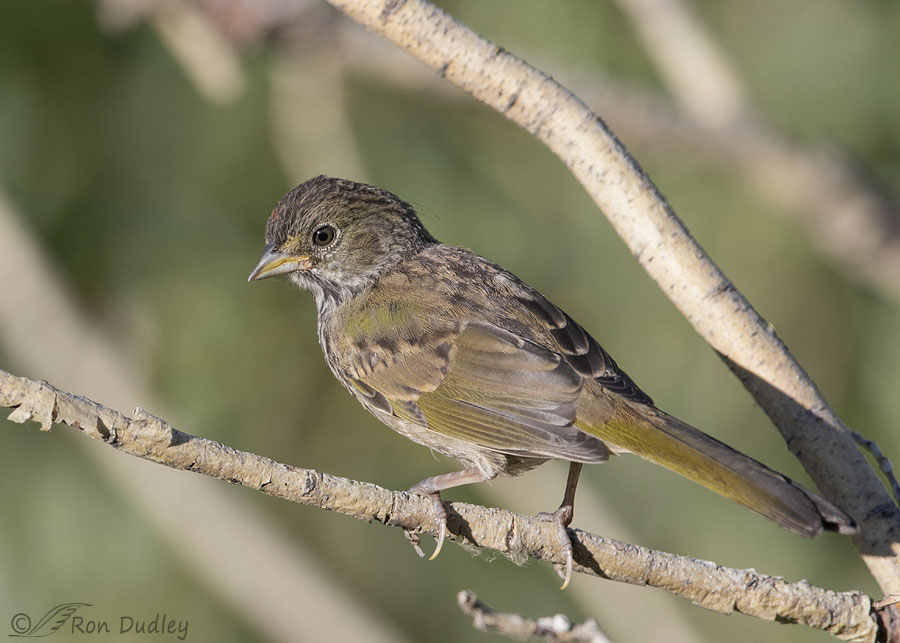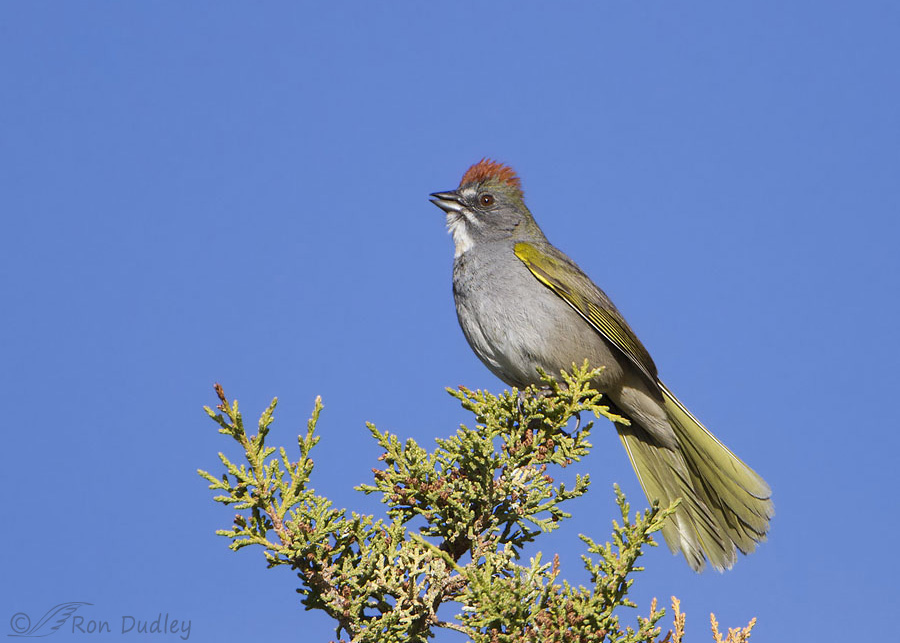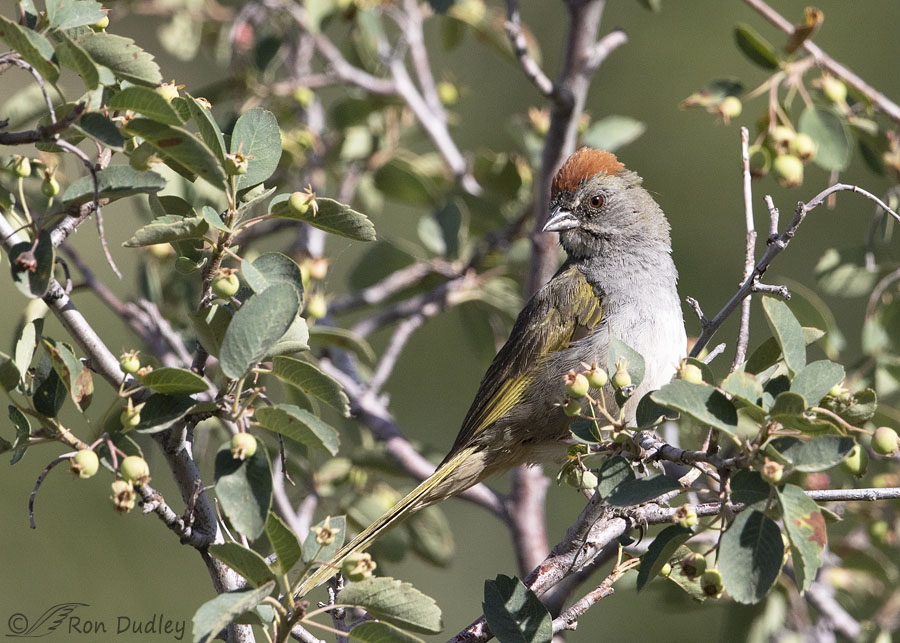Including my best documentary photo yet of a juvenile, taken earlier this week.

1/2500, f/6.3, ISO 800, Canon 7D Mark II, Canon EF 500mm f/4L IS II USM + EF 1.4 III Extender, not baited, set up or called in
Two days ago in the mountains this juvenile Green-tailed Towhee landed below and behind me and it was very close but while shooting from my pickup the angle out my window was so awkward I had to contort myself into such a position I almost broke my neck trying to get some photos of it (no kidding).
I wouldn’t call it a pretty shot but it’s my best and most detailed documentary photo of a juvenile to date.
As in many species juvenile Green-tailed Towhees look much different than adults. They’re mainly brownish gray above and almost white below with dark streaking throughout but the green on their tails and wings gives them away. To my eye that looks like green down feathers on the lesser coverts “shoulder”. Juveniles lack all of the more striking and contrasting plumage characteristics of the adult.

1/2000, f/5.6, ISO 540, Canon 7D, Canon EF 500mm f/4L IS II USM + EF 1.4 III Extender, not baited, set up or called in
If it survives long enough this is what the juvenile will grow up to look like. Adults (both sexes) are unmistakable with olive green upperparts and tail, gray breast, bold throat markings and conspicuous reddish brown cap. This photo from my archives with the tail slightly flared shows the green on the ventral surface of that long tail. Until I took this shot I didn’t even know the ventral tail surface is also green.
Finding this species out in the open like this is pretty unusual in my experience. This presumed male was singing on territory but usually they’re scurrying around on the ground or…

1/3200, f/6.3, ISO 800, Canon 7D Mark II, Canon EF 500mm f/4L IS II USM + EF 1.4 III Extender, not baited, set up or called in
buried in low vegetation as they’re foraging for food so it’s nearly always extremely challenging to get a clear shot. This photo, taken three days ago, demonstrates their affinity for dense habitats.
As a result they’re difficult to photograph, observe and study, which is one of the reasons Cornell’s BNA Online refers to them as “one of North America’s least well-known birds.”
Ron


Fantastic shots Ron!
Charlotte
Thanks, Charlotte.
Ron, wanted to point out that your description of the Towhee [2nd photo] mentions “conspicuous reddish brown cap”, so I don’t think you forget to point it out [unless I’m missing something].
The adult male is beautiful with the various shades of green. Thank you, Ron
Alice, the “conspicuous reddish brown cap” I mentioned applied to the description of the adult. What I hadn’t noticed was the slight tinge of red in the juvenile (first photo).
Love the promise of the beauty he/she will grow into (the hint of red on the head and the glorious greens).
Yet another charmer.
Thank you, EC.
Nice series Ron. Love the juvenile with the kind of olive drab military look. He will soon grow to be a handsome adult much like the ones you show here. Sadly I have never seen one here, but sure wish we did have them. Maybe going a little farther north such as around Flagstaff etc.
I’ll bet the Flagstaff area would be a good bet for them, Everett.
Beautiful birds and photos. Recognized the juniper and serviceberry but didn’t know there was a Green-tailed Towhee. Probable because it doesn’t occur here; 1 sighting in 1985. Perhaps climate change will bring them this way.
Lyle, I often see them in shrub-steppe environments dominated by sagebrush. In breeding season look for them there if you have it.
You’ve made it impossible to pick a favorite shot, Ron. They’re all super! The juvie makes me smile, as it looks like he’s gonna need to grow into that giant head of his. 😄
Sounds like it may be time to treat yourself to a massage.
Marty, I went to a chiropractor for years. After each treatment he threw in a free massage done by a masseuse. I never liked them so after a couple of times I always turned them down. To me they were just a waste of time.
Adorable baby face! I get them occasionally in my yard.
I’m jealous, April. About all I get in my yard anymore is starlings and sparrows with a sprinkling of others at certain times of the year.
Wow– that second shot ! There’s more than the Towhee singing— the colors in the whole frame absolutely ‘SING’ as well– what a pleasure to see !
Thanks, Kris. I wasn’t particularly close to the bird but I’ve always liked that shot.
Nice to see these great photos of a bird I shall probably never see up close. I find the eyes are one of the first thing to draw me in…piercing I guess might best describe them. They look to be of the same sharpness as the Eastern Towhee we see here during breeding season. Apparently both species are as secretive in their habitat…heard before seen. I noticed that hint of rufous on the head; they certainly have a lovely mix of colors as an adult. Your second photo certainly portrays them beautifully.
I guess I’ve got to start paying more attention. Both you and Judy noticed that hint of red on the head and I didn’t, even though I spent quite a bit of time processing the image. Thanks, Kathy.
Nice! Can even see the start of the red on the juvenile’s head…. 🙂 Very different color combination with the grey/rusty red/olive green which I think of more in tropical birds. Unless under the feeder the Spotted Towhees here are heard more than seen occasionally startling me. Hope your neck “gets over it” quickly….. 🙂 On that note I take it your back survived the Centennial Valley workout fairly well?
You’re right, there is a tinge of red up there. Good eye Judy, I hadn’t noticed.
I hear Spotted Towhees often too – not their song so much as their scratching around on the ground beneath vegetation where I can’t photograph them. Frustrating.
My back survived. How well is open for debate.
One of the beauties of photographs are that they bring back memories. Back in the 80’s we took a family summer sabbatical from teaching. We hit Glacier around a week after the 4th of July. Besides seeing friends that had moved west, it gave us a chance to see birds and mammals we had only read about.
Great shot of the immature, nice detail even if you had to be contorted to get the shot, well worth the effort!
“even if you had to be contorted to get the shot, well worth the effort!”
I dunno, Dick – my neck is still paying the price. Thank you.
Ya, I know, its easy for me to say, I didn’t have to go through the pain! But, the proof is in the pudding, and that is one hell of a shot!!
About a minute later that bird actually came back to almost the same spot and allowed me some more shots. Pretty unusual for that to happen with towhees.
The juvenile is really fabulous. You got that tint of green. Good morning.
Thank you, Arwen. Good morning.